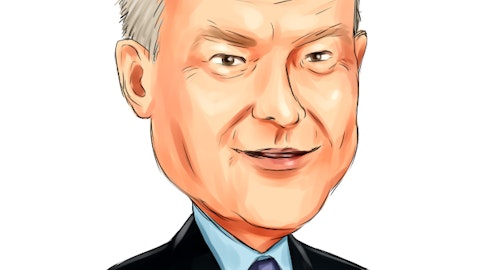Fei Chen: I mean this is a very, very relevant question. When I come in 2022 — late 2022, and I realize we have to build up a sales pipeline because we do not have very nice sales pipeline at all. And that’s what we have done in 2023, the whole year to build up the new sales team and the sales pipeline. So I would say very confidently and the project we made working into 2024 is based on the pipeline and that’s why it’s much more improved than 2023.
Lucas Ward: Okay. So it is getting better. Can you also help us understand that sales cycle? Again, it seems like a really important thing. Like you’ve talked about the need to shorten it. When you look at system sales, as an example, what is the time between you would typically get an order and when you would actually book revenues?
Fei Chen: I mean this — we have different segments, right? Each of the segments are different. And if I take the commercial pool system as example, what we really have been doing in 2023 is really reduce the cycle from we got order to we deliver, so we can book the revenue. And we have standardized our design and we streamline our production so the delivery time has reduced from 24 weeks to 6 weeks. So that means when we got order today, maximum 6 weeks, we were able to convert that into revenue. And that’s really a significant improvement compared with before.
Lucas Ward: Okay. I guess in some of the target markets where you’re still developing it, that you can’t just do that right off the bat. But the goal over time is to get that kind of efficiency. Is that fair?
Fei Chen: Exactly. What we are doing is we are actually trying to standardize all the solutions for our system market. So in this way, we are able to really reduce the converting time and also reduce — to increase the quality and the stability of our system. So this is what we are working on across all the product lines, actually.
Lucas Ward: Okay. Just shifting over to the regulatory environment. Would you say that overall, it’s getting better for LiqTech? Or are we going backwards? For instance, we’ve seen sort of a backlash against ESG. I mean what are you seeing when you go out and try and sell your systems in terms of the regulatory tailwind or headwind?
Fei Chen: I mean if you’re talking from the macroeconomic point of view, definitely we’re seeing the megatrends for the water scarce and for energy efficiency and also for the air pollution improvement. So we are really having some very good megatrends on our back, so we really have some big potential. And one of the things we actually learned from our marine scrubber market is we have to be going out to work with customers. So have their needs, not only based on regulatory requirement alone, really based on their — also their business needs. So you can see the market we are working today there are a majority of them, not only based on the regulatory approve — the requirement, it’s also because the customer really has the need.
Of course, the DPF area is very much regulatory driven, but we have some very good strengths there, like a black carbon emission for marine type industry. It’s really more and more enforcement there and also the emergency generator for data center with all these artificial intelligence going in the world. More and more data center required and they have to have the installed [ph]. So there are some really strong victory in these areas. And then the oil gas, as I discussed before, [indiscernible] is not only on the regulatory requirement, it’s also about the company really have actual needs they would like to reuse the water. So in that way, we are kind of more stable than only rely on the regulatory requirements.
Lucas Ward: Got it. Got it. Okay. Just a financial question or two. Do you have your revenue growth outlook at this point?
Phillip Price: So we only comment for the next quarter. And what we guide for is if you can compare it to the just-ended quarter, we expect revenue growth of 3% to 8%.
Lucas Ward: Okay. Is that — so does that — should we take from that, that your visibility is not — that you’re confident about your visibility that we would just be looking to [technical difficulty]?
Fei Chen: No, the reason we don’t make them longer than that is you know our mix — product mix is quite complicated and some projects are very big, some projects small. And so the dynamic is changing very much. So that’s why we do have the forecast for whole year, but [indiscernible] change in mix it’s very difficult to say exactly when it’s coming. So we feel it’s more reliable to tell a quarter of time in this way, we know exactly what is going to happen because the dynamic is very difficult to reflect if you retain the [indiscernible].
Lucas Ward: Okay. Okay. Last question, and thanks for indulging me. What do you — based on the mix that you’re targeting, let’s say, over the next year or two, what is your breakeven accounting breakeven revenue run rate?
Phillip Price: So as we also mentioned before, we are still comfortable that our breakeven target, revenue target is $7 million. It could be lower depending on the revenue mix, but that’s what we’re aiming at.
Fei Chen: $7 million per quarter.
Phillip Price: Yes.
Fei Chen: So if we’re able to achieve $7 million a quarter, we will be able to reach breakeven.
Lucas Ward: Okay, got it. Okay. Thank you so much for answering all my questions.
Fei Chen: Thank you very much.
Operator: Thank you. [Operator Instructions] The next question comes from Craig Rose with Axiom Asset Management. Please go ahead.
Craig Rose: Hello, guys. Thanks for taking my questions. As far as the produced water pilot programs that you’re initiating with Middle East and with Razorback Direct, what are the capital requirements to execute on those?


